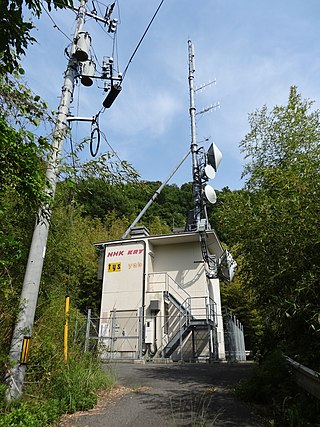A television broadcaster or television network is a telecommunications network for the distribution of television content, where a central operation provides programming to many television stations, pay television providers or, in the United States, multichannel video programming distributors. Until the mid-1980s, broadcast programming on television in most countries of the world was dominated by a small number of terrestrial networks. Many early television networks such as the BBC, CBC, PBS, PTV, NBC or ABC in the US and in Australia evolved from earlier radio networks.

The Coquimbo Region is one of Chile's 16 regions. It is bordered by Atacama to the north, Valparaíso to the south, Argentina to the east, and the Pacific Ocean to the west. It is approximately 400 kilometres (250 mi) north of the national capital, Santiago.

Terrestrial television or over-the-air television (OTA) is a type of television broadcasting in which the content is transmitted via radio waves from the terrestrial (Earth-based) transmitter of a TV station to a TV receiver having an antenna. The term terrestrial is more common in Europe and Latin America, while in Canada and the United States it is called over-the-air or simply broadcast. This type of TV broadcast is distinguished from newer technologies, such as satellite television, in which the signal is transmitted to the receiver from an overhead satellite; cable television, in which the signal is carried to the receiver through a cable; and Internet Protocol television, in which the signal is received over an Internet stream or on a network utilizing the Internet Protocol. Terrestrial television stations broadcast on television channels with frequencies between about 52 and 600 MHz in the VHF and UHF bands. Since radio waves in these bands travel by line of sight, reception is generally limited by the visual horizon to distances of 64–97 kilometres (40–60 mi), although under better conditions and with tropospheric ducting, signals can sometimes be received hundreds of kilometers distant.
Twin Cities Public Television, Inc. is a nonprofit organization based in Saint Paul, Minnesota, United States, that operates the Twin Cities' two PBS member television stations, KTCA-TV and KTCI-TV, both licensed to Saint Paul. It produces programs for local, regional and national television broadcast, operates numerous websites, and produces rich media content for Web distribution.
CBUFT-DT is an Ici Radio-Canada Télé station in Vancouver, British Columbia, Canada, which serves the province's Franco-Columbian population and Franco-Yukonnais in Yukon. It is part of a twinstick with CBC Television station CBUT-DT. Both stations share studios at the CBC Regional Broadcast Centre on Hamilton Street in downtown Vancouver, while CBUFT-DT's transmitter is located atop Mount Seymour in the district municipality of North Vancouver.

KVRR is a television station in Fargo, North Dakota, United States, affiliated with the Fox network. Owned by Coastal Television Broadcasting Company, the station maintains studios on South 40th Street and South 9th Avenue in Fargo, and its transmitter is located near Tansem, Minnesota. KVRR also handles master control and some internal operations for sister station and fellow Fox affiliate KQDS-TV in Duluth, Minnesota.

Telecaribe is a regional television network for the Caribbean region of Colombia.
A pirate television station is a broadcast television station that operates without a broadcast license. Like its counterpart pirate radio, the term pirate TV lacks a specific universal interpretation. It implies a form of broadcasting that is unwelcome by the licensing authorities within the territory where its signals are received, especially when the country of transmission is the same as the country of reception. When the area of transmission is not a country, or when it is a country and the transmissions are not illegal, those same broadcast signals may be deemed illegal in the country of reception. Pirate television stations may also be known as "bootleg TV", or confused with licensed low-power broadcasting (LPTV) or amateur television (ATV) services.
In broadcasting, digital subchannels are a method of transmitting more than one independent program stream simultaneously from the same digital radio or television station on the same radio frequency channel. This is done by using data compression techniques to reduce the size of each individual program stream, and multiplexing to combine them into a single signal. The practice is sometimes called "multicasting".

WTGL is a religious independent television station licensed to Leesburg, Florida, United States, serving the Orlando area. The station is locally owned by Good Life Broadcasting, and maintains studios on Skyline Drive in Lake Mary, Florida. Through a channel sharing agreement with PBS member station WUCF-TV, the two stations transmit using WUCF-TV's spectrum from an antenna near Bithlo.
The Ridge Hill transmitting station is a broadcasting and telecommunications facility located 8.5 miles SE of Hereford in Herefordshire, and close to the border of Gloucestershire. The station transmits the full complement of digital terrestrial multiplexes and an additional ITV West Multiplex. It includes a cable stayed steel lattice mast which has a height of 164.6 metres (540 ft), which in addition to the altitude of the site gives an aerial height of 363 metres (1,191 ft) above mean sea level.

A broadcast relay station, also known as a satellite station, relay transmitter, broadcast translator (U.S.), re-broadcaster (Canada), repeater or complementary station (Mexico), is a broadcast transmitter which repeats the signal of a radio or television station to an area not covered by the originating station.
The Crown dependency of the Isle of Man does not have any television channels of its own but receives United Kingdom television channels.

Panamericana Televisión is a Peruvian television network, which was founded on July 21, 1957 and had later begun its official broadcast on October 16, 1959.
Television in Peru has a history of more than 60 years. There are 105 television broadcasters in Peru, 22 of which are in Lima. In regard to television receivers, in 2003 there were 5,470,000 — that is 200 televisions for every thousand inhabitants. The number of cable subscribers was 967,943 in 2011.
Digea is a Greek network operator that provides a digital terrestrial television system in Greece for seven nationwide free-to-air channels. In addition to these free-to-air nationwide stations, the network is open to any other station choosing to use its services.
UCV Satelital is a Peruvian television network with regular broadcasts since 2003 and belongs to the Cesar Vallejo University. Emits its signal from Victor Larco District of Trujillo city and some programs are in their respective affiliates in other cities of northern Peru.

Sol TV is a Peruvian television station, which transmits its signal since 2003, from Trujillo city for Peru. The channel belongs to the company Cruzado Saucedo. It was the first regional channel airing in the city of Trujillo.

The Whitehawk Hill transmitting station is a broadcasting and telecommunications facility located at Whitehawk, an eastern suburb of Brighton in the English city of Brighton and Hove. It is the city's main transmission facility for television and radio signals. It broadcasts digital television, FM and DAB radio to the coastal city of Brighton and Hove and to surrounding areas along the Sussex coast including Shoreham-By-Sea, Worthing and as far as Seaford. It stopped broadcasting analogue television when the digital switchover occurred locally in March 2012.
Grupo ATV is a media conglomerate Peruvian television communication company created in 2006, which is owned by the Albavisión conglomerate, owned by Remigio Ángel González.









